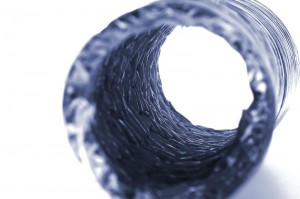With the hustle and bustle of everyday life, plenty of homeowners count on the benefits offered by the updated appliances in their homes without a second thought. The refrigerator and freezer maintain the freshness of food, the oven bakes tasty meals and the washer and dryer facilitate the process of cleaning clothes. While these appliances seem to work relentlessly to improve our day to day life, they do need scheduled maintenance to continue working correctly. In some instances, these regular repairs can be lifesaving.
You clean out the lint trap before and after every load of clothes, so you may assume that your dryer would never catch on fire. Although this practice decreases the risk of fire, you are not completely safe. Lint not only builds up in the lint trap inside your dryer but also in the dryer vent that the hot air uses to leave your home. Over time this aluminum hose gathers lint, fibers, dust and other debris – maybe even small animals – and as this mass builds up, so does the risk of fire. Lint is very flammable and any obstruction in the vent results in the accumulation of hot air from the dryer, meaning the lint and other debris could ignite with little warning.
According to the U.S. Fire Administration, an average of 2,900 residential lint fires were reported across the country every year between 2008 and 2010. These fires caused an average of almost $10,000 in damages. While the majority of the fires stayed confined to the dryer unit, if they moved past the floor of origin, the costs shot up to nearly $50,000. About half of the fires could have been prevented by proper use and maintenance of the dryer and most of them started with the ignition of lint or clothing in the unit.
To steer clear of these potential disasters, you must first make certain your dryer and vent have been installed correctly. Your dryer vent should go straight outside and never into a confined area, such as an attic, garage, or crawlspace. Preferably, the vent should measure shorter than 35 feet, with as few bends as possible, and should be made of only metal, because plastic and vinyl increases fire risk. Also make sure that the vent opens outside when the dryer runs to ensure good air flow and closes when the dryer stops to keep water, debris and animals out of the vent. All of this can be checked for safety by a professional during the annual inspection.
You can also avoid dryer fires by thoroughly cleaning your dryer, the surrounding area and the vent on a regular basis. Before every load of clothes, clear off the lint trap in the machine, and twice every year, scrape the built up debris from the trap with a nylon brush. Also use a vacuum attachment to eliminate lint from farther inside the lint trap opening.
In addition to these practices, you should also have your dryer vent professionally inspected and cleaned on a regular basis. An expert can spot an improperly installed dryer or vent, clear your vent of any dangerous debris and leave you with peace of mind. If you live near Elkton, Maryland, contact Ace Chimney Sweeps for a professional consultation.

